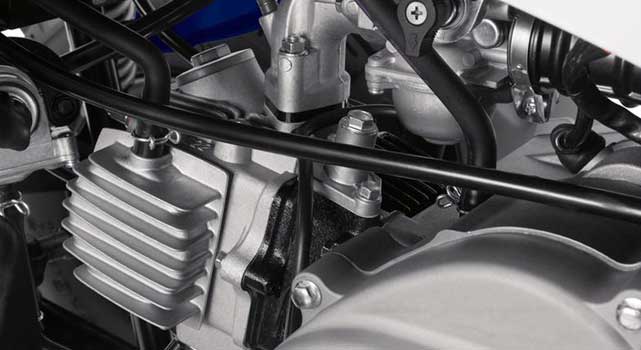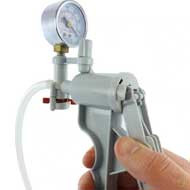How to Find Engine Vacuum Leaks
Mar 19th 2019
How to Find Engine Vacuum Leaks

In order for an internal combustion engine to work efficiently, a proper air and fuel must be mixed within the combustion chamber. This mass ratio of air to solid, liquid, or gaseous fuel is called the air/fuel ratio.
The air/fuel ratio is crucial for both emissions control and engine performance. When an engine runs rich, there is more fuel per parts air. When an engine runs lean, there is more air per parts fuel. Depending on the application, an engine can purposely be tuned to run either rich or lean. Engines that run rich are typically less fuel-efficient and produce more combustion byproduct, but generate more power at lower temperatures. Engines that run lean (such as the standard tuning in most economy cars) produce less power and run hotter, but at the advantage of increased efficiency and a significantly lower output of dangerous hydrocarbons and other pollutants.
Engine vacuum is the difference in air pressure between the engine intake manifold and the atmosphere. A vacuum leak is when excess air is inducted into the intake manifold and disrupts the balance of the air/fuel ratio. This can result in rough, choppy idle or even an elevated idle speed. Of course, the more familiar you are with your engine’s performance, you will know when something’s not quite right. Vacuum leaks tend to appear between the cylinder head and the butterfly valve of the carburetor. In this quick write-up, we’ll show you the most common spots for vacuum leaks to occur, how to diagnose them, and what to do to correct them.
#1: CARBURETOR INTAKE BOOT
A carburetor intake boot (AKA: carburetor/carb holder or carb intake holder) is a rubber tube that moves fuel into the cylinder head. As with hoses, tires, bushings, or any rubber part, these carburetor boots can deteriorate over time. Repeated exposure to heat and the sun’s ultraviolet rays, as well as the corrosive properties of fuel itself to rubber contribute to the aging effect of rubber. When the rubber of the carb boot starts to rot, small cracks and pinholes form which can draw in extra air from the atmosphere into the intake.
INSPECTION
Fire the engine. With a can of carburetor cleaner or starter fluid, spray the carb boots. If you hear the engine RPMs either speed up or slow down, this can be a sign of a vacuum leak. Be sure to quickly wipe away any chemical spray once you’ve concluded your test (carburetor cleaner and starter fluid can melt away paint and promote accelerated rubber deterioration).
SUGGESTED SOLUTION
Replace the carburetor boot(s). Race Driven sells brand new replacement carburetor intake boots for Polaris and Yamaha ATVs.
#2: FUEL PETCOCK DIAPHRAGM AND INTAKE TUBING
As in the case of the carb boot, the petcock diaphragm and intake tubing is made of rubber. Thus, these parts will also experience the same degradation. This, however, is a less-common source of engine vacuum leak than that of the carb boot. Nevertheless, these should still be taken into consideration if your engine’s performance is suffering from idle fluctuations.
INSPECTION
Attach a hose and a vacuum pump to the petcock inlet. Begin to pump pressure. Check the gauge dial on your vacuum pump. If the needle starts to dip, that means a drop in pressure and a vacuum leak is definitely present.
SUGGESTED SOLUTION
Replace the fuel petcock diaphragm and/or rubber intake tubing. Replacing the petcock diaphragm is a somewhat involved process and on older engines, it may be easier (albeit, more costly) to swap out the entire petcock.
#3: HEAD GASKETS
Gaskets form the seal between attached engine parts. These form the barrier that allow for proper internal pressure. If an engine has had recent top-end repair or overhaul work performed, it may be possible that the gaskets have not been seated properly. Alternatively, gaskets can blow due to age or heavy use. Gasket leaks of any kind should be addressed immediately as continuing to operate the engine in this condition can ultimately lead to destruction of the entire engine itself.
INSPECTION
Blown or unseated gaskets can usually be detected through visual inspection and through scent. Look for fluid leaks, weeping, or dampness near the cylinder head, intake manifold, or carburetor/throttle body. Also, take note of any strong smells of fuel vapor or burnt runoff.
SUGGESTED SOLUTION
Replace the warped/damaged gasket. Pay close attention to the alignment and never ever force a gasket to seat; this suggests improper fitment. Race Driven sells complete gasket kits for powersports vehicles by Arctic Cat, Honda, Kawasaki, Polaris, Ski-Doo, Suzuki, and Yamaha.
These are the three most common areas of your engine that can develop vacuum leaks. When you bring your vehicle out of storage, when you do your regularly scheduled maintenance service, or if you are purchasing a used or older powersports machine, don’t neglect to inspect these components for wear or damage.


